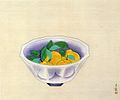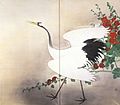Kokei Kobayashi
You can help expand this article with text translated from the corresponding article in German. (May 2019) Click [show] for important translation instructions.
- Machine translation, like DeepL or Google Translate, is a useful starting point for translations, but translators must revise errors as necessary and confirm that the translation is accurate, rather than simply copy-pasting machine-translated text into the English Wikipedia.
- Do not translate text that appears unreliable or low-quality. If possible, verify the text with references provided in the foreign-language article.
- You must provide copyright attribution in the edit summary accompanying your translation by providing an interlanguage link to the source of your translation. A model attribution edit summary is
Content in this edit is translated from the existing German Wikipedia article at [[:de:Kobayashi Kokei]]; see its history for attribution. - You may also add the template
{{Translated|de|Kobayashi Kokei}}to the talk page. - For more guidance, see Wikipedia:Translation.
Kokei Kobayashi | |
|---|---|
 circa 1953 | |
| Born | Shigeru Kobayashi (1883-02-11)February 11, 1883 Takada, Niigata Prefecture, Japan |
| Died | April 3, 1957(1957-04-03) (aged 74) |
| Nationality | Japanese |
| Education | Kajita, Hanko |
| Known for | Painter |
| Movement | Nihonga |
| Awards | Order of Culture(1950), Person of Cultural Merit(1951) |
Kokei Kobayashi (小林古径, Kobayashi Kokei, February 11, 1883 – March 3, 1957) was a Japanese Nihonga painter.[1]
Biography
He became an orphan early in his life, at the age of 17 he moved to Tokyo and studied traditional Japanese painting at Kajita Hanko.[2] Later he became one of the most notable members in the Restored Japan Academy of Art.[3]
Initially, he painted traditional subject matter ("Taketori monogatari"-1914 as an example) but later he continued with still life and contemporary scenes. His famous works include: "Amida-dō" (1914), "Ideyu" (1918) and "Kami" (1931).[3]
He was friends with Tamako Kataoka (1905–2008).
He was awarded the Order of Culture.
Works
-
 Fruit (1910)
Fruit (1910) -
 In the Bath (1918)
In the Bath (1918) -
 Magnolia Tree (1919)
Magnolia Tree (1919) -
 Hair (Unknown Date)
Hair (Unknown Date) -
 Turkey (1928)
Turkey (1928) -
 White flowers and bird (1930s)
White flowers and bird (1930s) -
 "Cherry Blossom" (1930s)
"Cherry Blossom" (1930s) -
 Crane (1928)
Crane (1928)
See also
- Seison Maeda (1885–1977), one of the leading Nihonga painters
- List of Nihonga painters
References
External links

Wikimedia Commons has media related to Kobayashi Kokei.
- Artnet | Kobayashi Kokei
- Google Cultural Institute | Kobayashi Kokei
- v
- t
- e



















